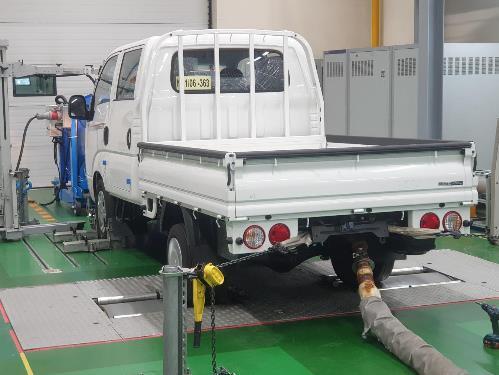Conversion of industrial urea solution for vehicle use impossible: state lab
By YonhapPublished : Nov. 16, 2021 - 15:53

A proposed conversion of industrial-use urea or urea solution into vehicle-use solution is impossible right now, a state-run laboratory said Tuesday, dashing hopes for an early end to the nation's acute shortage of the chemical compound.
The National Institute of Environmental Research (NIER) under the Ministry of Environment said it has tentatively concluded it is difficult to convert industrial urea or urea solution for use by diesel-fueled vehicles to cut emissions.
South Korea has been making a flurry of diplomatic efforts to secure urea and its solution from other countries to avert a potential logistics crisis amid a supply shortage caused by China's export curbs of urea.
NIER has conducted the rare conversion test to take advantage of the nation's vast stockpiles of industrial urea solution to cope with the shortage of vehicle urea solution.
The institute said that industrial urea or urea solution, if converted to vehicle-use solution, can meet air pollutant regulation standards but additional experiments are needed because other environmental impacts and effects on vehicles are not specifically verified.
Diesel cars manufactured and imported after 2016 have a selective catalytic reduction device to reduce the emission of nitrogen oxides exhausted from diesel engines under environmental regulations.
NIER said it had conducted the urea solution conversion tests for 11 days from Nov. 2 by injecting samples of non-vehicle urea from steel mills and thermal power plants into diesel vehicles to examine whether exhaust gas meets the pollutant emission standards.
Compared with vehicle urea solution, the concentration of air pollutants emissions was generally similar, but the amount of aldehyde, a toxic substance, decreased only by 7.9 percent in one sample and rather increased by 19.8 percent in another sample, the institute noted.
Urea solution manufacturers, automakers and environmental experts have all suggested that additional tests are desirable to more accurately evaluate the environmental impacts of the conversion, NIER said, adding results of additional tests will be available by the end of next week. (Yonhap)
The National Institute of Environmental Research (NIER) under the Ministry of Environment said it has tentatively concluded it is difficult to convert industrial urea or urea solution for use by diesel-fueled vehicles to cut emissions.
South Korea has been making a flurry of diplomatic efforts to secure urea and its solution from other countries to avert a potential logistics crisis amid a supply shortage caused by China's export curbs of urea.
NIER has conducted the rare conversion test to take advantage of the nation's vast stockpiles of industrial urea solution to cope with the shortage of vehicle urea solution.
The institute said that industrial urea or urea solution, if converted to vehicle-use solution, can meet air pollutant regulation standards but additional experiments are needed because other environmental impacts and effects on vehicles are not specifically verified.
Diesel cars manufactured and imported after 2016 have a selective catalytic reduction device to reduce the emission of nitrogen oxides exhausted from diesel engines under environmental regulations.
NIER said it had conducted the urea solution conversion tests for 11 days from Nov. 2 by injecting samples of non-vehicle urea from steel mills and thermal power plants into diesel vehicles to examine whether exhaust gas meets the pollutant emission standards.
Compared with vehicle urea solution, the concentration of air pollutants emissions was generally similar, but the amount of aldehyde, a toxic substance, decreased only by 7.9 percent in one sample and rather increased by 19.8 percent in another sample, the institute noted.
Urea solution manufacturers, automakers and environmental experts have all suggested that additional tests are desirable to more accurately evaluate the environmental impacts of the conversion, NIER said, adding results of additional tests will be available by the end of next week. (Yonhap)





![[From the Scene] Monks, Buddhists hail return of remains of Buddhas](http://res.heraldm.com/phpwas/restmb_idxmake.php?idx=644&simg=/content/image/2024/04/19/20240419050617_0.jpg&u=20240419175937)





![[Graphic News] French bulldog most popular breed in US, Maltese most popular in Korea](http://res.heraldm.com/phpwas/restmb_idxmake.php?idx=644&simg=/content/image/2024/04/18/20240418050864_0.gif&u=)



![[From the Scene] Monks, Buddhists hail return of remains of Buddhas](http://res.heraldm.com/phpwas/restmb_idxmake.php?idx=652&simg=/content/image/2024/04/19/20240419050617_0.jpg&u=20240419175937)

![[KH Explains] Hyundai's full hybrid edge to pay off amid slow transition to pure EVs](http://res.heraldm.com/phpwas/restmb_idxmake.php?idx=652&simg=/content/image/2024/04/18/20240418050645_0.jpg&u=20240419100350)

![[Today’s K-pop] Illit drops debut single remix](http://res.heraldm.com/phpwas/restmb_idxmake.php?idx=642&simg=/content/image/2024/04/19/20240419050612_0.jpg&u=)